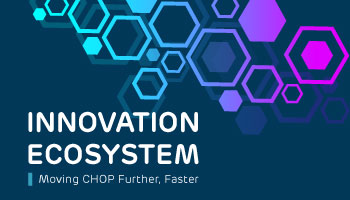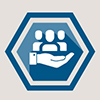HOW CAN WE HELP YOU? Call 1-800-TRY-CHOP
In This Section
CHOP’s Innovation Ecosystem: Moving Ideas Further, Faster

Click on image above to listen to Drs. Winston and Ferro discuss the Innovation Ecosystem on CHOP’s Podcast “Primary Care Perspectives: Episode 78 - Innovation and Improvement in Pediatrics.”
Each day employees across Children’s Hospital of Philadelphia attempt to convert innovative ideas into new products, services, or processes. But how do you translate abstract concepts and knowledge into actual value for CHOP’s patients, families, community, and the hospital’s operations and systems? With an Innovation Ecosystem, of course.
Borrowing a lesson from biology class, Flaura Winston, MD, PhD, director of CHOP’s Innovation Ecosystem (IE) explained, “We’re used to thinking about ecosystems as communities of interacting organisms and their physical environment. Well, the reality is, for innovation to be successful here, we also need a complex interconnected system with supports that will allow us to be as efficient as possible.”
And that’s exactly what the IE is — an interdepartmental team whose mission is to foster a connecting infrastructure among CHOP’s many innovation hubs, such as Frontier Programs, the Chair’s Initiatives, and the Office of Entrepreneurship and Innovation, that provide support to CHOP’s innovators in the form of funding, business planning, and technical and analytical expertise. They aim to make the innovation process inclusive and easily accessible to every employee with an idea that could improve the health and wellness of children.
“We see ourselves as bringing CHOP together so that everyone with a good idea is within one degree of separation of the resources, the talent, and the expertise they need in order to solve problems,” said Dr. Winston, who is also founder and scientific director of the Center for Injury Research and Prevention.
Pillars of Innovation
Four core pillars guide the IE team, in order to ensure that innovative ideas move through CHOP further and faster to achieve value: fostering an innovation-positive culture, building connections, growing capacity, and establishing innovation pathways and best practices.
“Our mission is to improve innovation by building connections, capacity, and culture,” said IE Co-director Daria Ferro, MD, a hospitalist at CHOP and a clinical informatician in the Department of Biomedical and Health Informatics, “and in that process, we want to find best practices and pathways that can be shared among all the groups within our network and outside. Our team’s work is all about helping people with ideas navigate the CHOP innovation landscape.”
Transforming Culture

Transform Culture
For innovation to thrive in an organization, a positive culture is vital — one that encourages learning from failures and doing things more efficiently, and one that enables an individual to feel like they can have a career as a clinical innovator. The Innovation Ecosystem team promotes a positive culture by bolstering a workplace environment that motivates, enables, supports, and gives permission to faculty and staff to seek new solutions.
Take the Innovation Communicators Group, for instance, led by Suzanne Hill, who’s in charge of strategy and communications for the Innovation Ecosystem. Formed early last year, its members meet quarterly to align communications for 10 innovation hubs, share best practice pointers, troubleshoot common barriers, and occasionally partner on projects to improve innovation processes and pathways that benefit all the programs.
Increasing Capacity

Increase Capacity
Understanding there was a need to improve the capacity of people to turn their ideas into action, the IE group created a free online educational resource titled, “Academic Entrepreneurship Book for Medical and Health Scientists,” a guide that answers questions clinicians or staff may have about entrepreneurship, rapid prototyping, new diagnostic tests, and much more. One of the advantages of this online resource is that it can be updated continually to accommodate the ever-changing nature of entrepreneurship — and science.
“As scientists, we’ve learned and practice the scientific method,” said Dr. Winston, one of the book’s editors, in a Cornerstone article about the e-book. “In order to take our great findings and realize their potential in saving lives and reducing suffering, there is a companion method — the discipline of innovation. What we’re doing in the Innovation Ecosystem is codifying this discipline and turning it into accessible content and full curricula for people who want to learn more.”
Building Connections

Build Connections
Building an innovator online community is an exciting project on the horizon for the IE team. It’s planned to be a moderated hub where users of the “Academic Entrepreneurship” resource will be able to communicate, contribute, and collaborate. For instance, entrepreneurial clinicians who become part of this community could collaborate with engineers or others to create products that will help their patients.
“We want to take the ‘Academic Entrepreneurship’ e-book and have it be living,” Dr. Winston enthused. “We’re going to turn it into a free community. So if you’re one person in one location who doesn’t have a network, then we can tap you into a larger network.”
Establishing Pathways

Establish Pathways
Establishing pathways and best practices is crucial, in order to take an idea and turn it into a new program, a new practice, or new product or therapeutic.
“It’s about capturing the intellectual capital of someone who has already done it,” Dr. Winston said, “and putting that information into a formal innovation pathway that can be widely shared. And if CHOP hasn’t done it before, the IE team will look at what other institutions are doing in terms of best practices.”
One such project underway addresses the critical supply chain shortages triggered by the pandemic and focuses on efficient delivery of technological solutions, such as 3D printed nasopharyngeal swabs for COVID testing. With a grant from the National Science Foundation, the Connected Rapid Innovation System to meet Identified needs with Solutions (the CRISIS System) involves developing best practice workflows for device development created from frontline identified needs — bringing the concept through the design, scaling, and testing process, and all the way back out to the delivery, as quickly and safely as possible.
“We don’t have the luxury of time anymore when it comes to innovation,” Dr. Winston said. “I’m not saying that we should rush things, but we need to at least be efficient with our time. We have fundamental changes that are needed to improve healthcare and to make its delivery more efficient and to cure diseases, even pandemic diseases. We need to have these pathways so that we can go further, faster.”